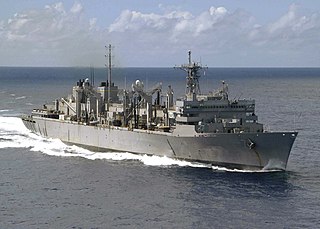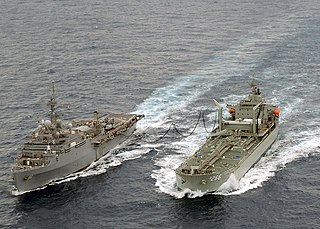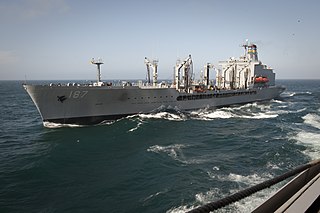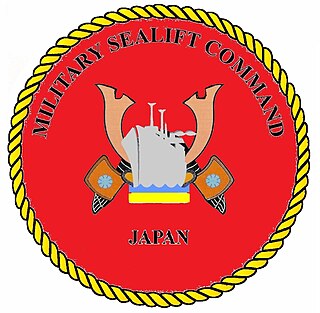
The fast combat support ship is a type of replenishment auxiliary ship. Different from traditional logistic ships, the fast combat support ship is designed with high speed to keep up with the carrier battle group/carrier strike group, while the multi-product station is capable of supplying all types of necessities for the fleet.

The Lewis and Clark class of dry cargo ship is a class of 14 underway replenishment vessels operated by the United States Navy's Military Sealift Command. The ships in the class are named after famous American explorers and pioneers.

The Military Sealift Command (MSC) is an organization that controls the replenishment and military transport ships of the United States Navy. Military Sealift Command has the responsibility for providing sealift and ocean transportation for all US military services as well as for other government agencies. It first came into existence on 9 July 1949 when the Military Sea Transportation Service (MSTS) became solely responsible for the Department of Defense's ocean transport needs. The MSTS was renamed the Military Sealift Command in 1970.

Combat stores ships, or storeships, are ships used to store naval supplies. They are used to deliver supplies such as provisions and fuel to combat ships on extended deployments. The United States Navy operated the Sirius and Mars classes and the Royal Navy operated the Fort Rosalie class and continues to operate one Fort Victoria class ship, having scrapped the other. They carried or carry the fleets's refrigerated stores, dry provisions, technical spares, general stores, fleet freight, mail and replacement personnel or specialists. Storeships should not be confused with fast combat support ships which are high speed auxiliary ships or tenders which provide maintenance support to flotillas.

USNS Yukon (T-AO-202) is a Henry J. Kaiser-class underway replenishment oiler operated by the Military Sealift Command to support ships of the United States Navy.

A replenishment oiler or replenishment tanker is a naval auxiliary ship with fuel tanks and dry cargo holds which can supply both fuel and dry stores during underway replenishment (UNREP) at sea. Many countries have used replenishment oilers.

USNS Arctic, formerly USS Arctic (AOE-8), is the third ship in the Supply class of fast combat support ships and is the fifth supply ship to carry the name of the region surrounding the North Pole.

An auxiliary ship is a naval ship designed to support combatant ships and other naval operations. Auxiliary ships are not primary combatant vessels, though they may have some limited combat capacity, usually for purposes of self-defense.

USNS Rainier (T-AOE-7), is a Supply-class fast combat support ship and the third US Navy vessel named after Mount Rainier. The ship was christened on 28 September 1991 by the ship's sponsor, Mrs. Suzanne Callison Dicks, wife of Congressman Norm Dicks, and commissioned as "USS Rainier (AOE-7)", on 21 January 1995 at Bremerton, Washington.

USNS Catawba is a Powhatan-class tugboat operated by the Military Sealift Command for the United States Navy. It is currently based in Manama, Bahrain. It was launched in 1979 and is the last ship of its class still in service. In December 2020, the Navy announced its intention to retire Catawba during fiscal year 2023.
Service Force, United States Pacific Fleet, usually known as COMSERVPAC, was a service support command of the United States Pacific Fleet from 1942 until 1973. It was the reincarnation of the former Base Force. The Service Force comprised the supply train of the fleet which includes Oilers (AO), Gasoline Tanker (AOG), Repair Ships (AR), Ammunition Ships (AE), Destroyer Tenders (AD) and Submarine tenders (AS).

USNS Apache (T-ATF-172) was a U.S. Navy Powhatan-class fleet ocean tugboat that was operated by the Military Sealift Command (MSC) from 1981 to 2022. She spent the bulk of her career in the Atlantic and Mediterranean.

USNS Kanawha (T-AO-196) is a Henry J. Kaiser-class fleet replenishment oiler of the United States Navy in non-commissioned service in the Military Sealift Command.

USNS Henry J. Kaiser (T-AO-187) is a United States Navy fleet replenishment oiler and the lead ship of her class. Her mission is to resupply U.S. Navy and allied ships at sea with fuel oil, jet fuel, lubricating oil, potable water, and dry and refrigerated goods, including food and mail.

USNS Supply (T-AOE-6), ex-USS Supply (AOE-6), is the lead ship of the Supply-class fast combat support ships. She was commissioned in 1994 and decommissioned in 2001, after which she was transferred for service with the U.S. Military Sealift Command.

The Powhatan class of fleet ocean tugs consists of seven ships built for the United States Navy, and operated by the Military Sealift Command (MSC). The lead ship of the class was launched in 1978 and the last ship in MSC service will be deactivated in 2023. During their service life, the Powhatan's were the most powerful tugs owned by the Navy.
The Next-Generation Logistics Ship (NGLS) is a programme being undertaken by the United States Navy to construct a fleet of medium-sized auxiliary ships that will provide underway replenishment (UNREPS), disaster relief and logistics capabilities for combined land and sea operations. These new vessels are not intended to replace existing classes such as the John Lewis-class replenishment oilers (AO) and the Supply-class fast combat support ships (AOE) but to supplement their operations, especially in littoral waters and combat zones where larger vessels cannot be risked.

Military Sealift Command Japan (MSC Japan) (軍事海上輸送司令部 (MSC) 日本) is an Echelon IV Command of the United States Navy responsible for training, equipping and maintaining Military Sealift Command's government-owned, government-operated sealift ships throughout the country of Japan. Headquartered in Yokohama at Yokohama North Dock and co-located with the US Army 836th Transportation Battalion, MSC Japan is Commanded by an Active Duty Naval Officer and staffed with the following organizational Departments: N1 (Administration), N3 (Operations/Port Operations), N4 (Logistics), N6 (Information & Technology Support), N7 (Port Engineer), N8 (Accounting), and N10 (Contract Support). MSC Japan operates two warehouses, one at North Dock (MSC's largest overseas warehouse) and one in Sasebo, Japan. These facilities provide logistics support for all MSC units operating within the Pacific theater.






















